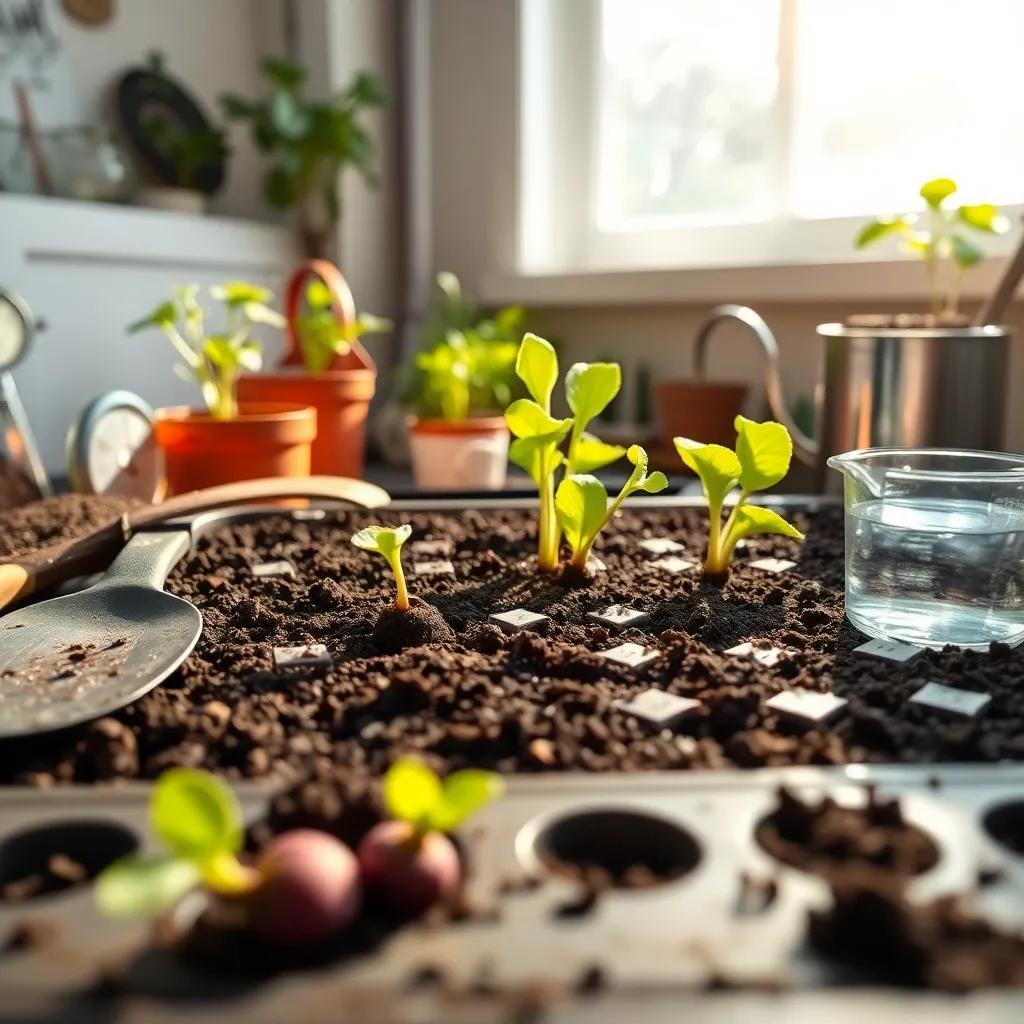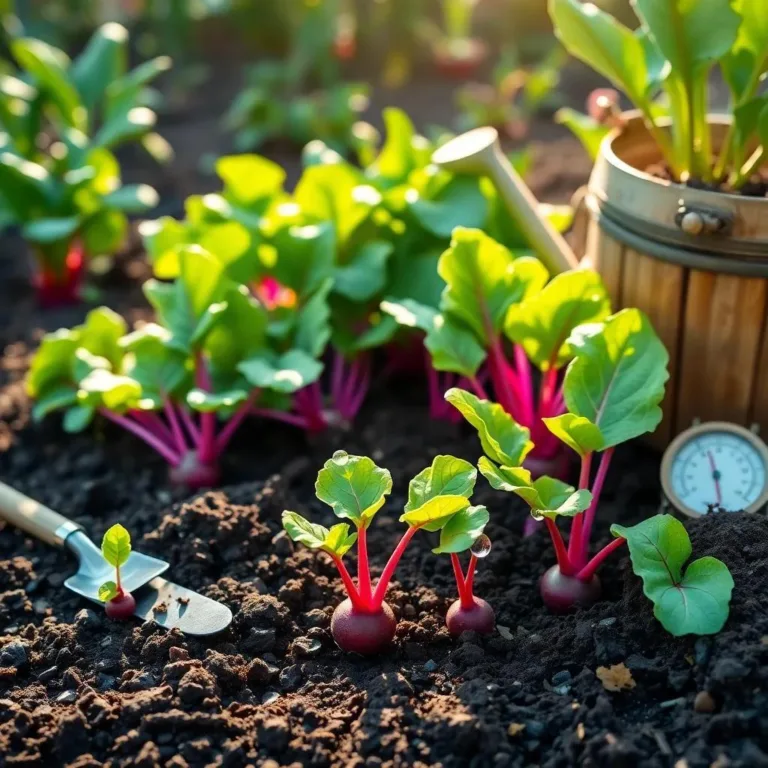Are you curious about growing your own delicious beets? Let’s explore the fascinating world of beet germination together! I’m excited to share tips, tricks, and insights that will help you turn those tiny seeds into vibrant, tasty veggies in no time! Ready to dig in?
Factors Influencing Beet Germination Time
When it comes to growing beets, several factors can influence how long it takes for those little seeds to sprout. Understanding these factors is key for those of us diving into the world of gardening! So, let’s check out what can affect beet germination.
- Temperature: Beets are like Goldilocks—they prefer temperatures that are “just right”! The ideal range for germination is between 50°F and 75°F (10°C and 24°C). If it’s too cold or too hot, those seeds might just sit there, pondering life. Isn’t it funny how seeds can be so picky?
- Moisture: Beet seeds need consistent moisture. I like to think of it like my morning coffee—just the right amount goes a long way! Keep the soil moist, but not soggy, during the germination period. If things get too dry, those seeds might give up on sprouting.
- Soil Quality: The better the soil, the happier the beets! Beets thrive in well-draining soil rich in organic matter. It’s like giving them a cozy blanket to sleep in! Mixing in compost can make the soil more inviting for our little sprouts.
- Seed Viability: Have you ever tried to use old seeds? It’s like trying to bake with expired flour! The freshness and quality of your seeds play a huge role in germination success. Always go for high-quality seeds from trusted sources.
- Light: Interestingly, beets don’t need light to germinate. They can sprout even in total darkness! But a little light later on helps those seedlings stand tall and proud. So, if you’re starting seeds indoors, a soft light can give them a boost!
By keeping these factors in mind, you can create a successful environment for your beet seeds. I can almost taste those sweet, roasted beets already!
Optimal Conditions for Fast Beet Germination
Now that we know what can influence germination time, let’s talk about the optimal conditions to get those beets sprouting as quickly as possible! Getting these conditions just right can make a world of difference.
- Temperature: Aim for that sweet spot of 50°F to 75°F. It’s best to plant beet seeds when the soil has warmed up to at least 50°F. A soil thermometer can be a handy little tool to keep track!
- Moisture: Make sure the soil is moist before planting, kind of like giving it a nice drink before the party! You want it to be evenly moist throughout the germination process. A light sprinkle of water can keep it hydrated, just like me with my morning drinks!
- Soil Preparation: Getting the soil ready is a key step! Remove any weeds and mix in organic matter like compost. This makes the soil fluffy and nutrient-rich, which beets absolutely love. Think of it as their spa day!
- Sowing Depth: When planting, make sure to cover those little seeds with about ½ inch of soil. It’s like tucking them in for a cozy nap! If they’re planted too deep, they might struggle to break through.
- Spacing: Don’t forget to give them room! Space the seeds about 1-2 inches apart. This way, they won’t crowd each other, and each beet can grow big and strong!
With these optimal conditions in place, you’re on your way to seeing some beautiful sprouts in no time! Happy gardening, friends! 🌱

Average Germination Timeline for Beets
So, you’re ready to plant those beet seeds, but when can you expect to see something sprout? Good question! The average germination time for beets typically ranges from 7 to 14 days. That’s right, it’s a bit of a waiting game, but it’s worth every minute!
Now, this timeline isn’t set in stone. Several factors can nudge that germination time in one direction or another. For instance:
- Temperature: If it’s a bit chilly, don’t be surprised if your seeds take longer to sprout. On the flip side, if things are warm and cozy, you could see those little green shoots popping up faster!
- Soil Moisture: Keeping the soil consistently moist but not soggy can positively impact germination speed. Remember, just like us, seeds don’t like their feet wet!
- Seed Quality: Fresh, high-quality seeds will germinate faster than those that have been sitting on a shelf for ages. So, always check that ‘best by’ date!
To keep track of your progress, I recommend marking the date you plant your seeds. It’s kind of like counting the days until a birthday—each day brings you closer to that moment of joy! Remember to keep an eye on your soil’s moisture levels and provide the right temperature. With a little patience, you’ll soon be on your way to enjoying some delicious beets!
Effective Tips to Enhance Beet Seed Germination
Want to speed things up a bit? I’ve got you covered with some effective tips to help enhance beet seed germination! These little tricks can work wonders and give your beets the boost they need to sprout quickly. Let’s take a look:
- Pre-soak the Seeds: Soaking your beet seeds in water for about 24 hours before planting can help soften the seed coating. This little step can kickstart the germination process!
- Scarify the Seeds: A bit of gentle abrasion can go a long way! Lightly nicking the seed coat with sandpaper or a nail file allows water to penetrate faster. Just be careful not to damage the seed!
- Provide Bottom Heat: Want those beets to feel like they’re on a cozy heating pad? Using a seedling heat mat can help warm the soil, encouraging quicker sprouting. Just be sure it’s not too hot, or you might stress them out!
- Use Quality Seed Starting Mix: A lightweight, well-draining seed starting mix promotes moisture retention and ensures that seeds have the right environment to sprout without drowning.
- Thin Out Seedlings: Once those seedlings peek above the soil, make sure to thin them out. If they’re too crowded, they won’t grow as strong. Think of it like giving them their own personal space to stretch out!
By using these tips, you’ll be well on your way to a thriving beet garden. I can almost smell those roasted beets now!
Common Germination Issues and How to Fix Them
Even the best gardeners face a few bumps in the road when it comes to beet germination. But don’t worry! Let’s explore some common issues you might encounter and how to tackle them like a pro.
- Poor Germination Rates: If your seeds aren’t sprouting, check their quality first. Old or low-quality seeds can be a real letdown! If they’re fresh, make sure the temperature and moisture levels are right. A quick check can save the day!
- Mold or Fungal Diseases: If you see fuzzy growth, it’s probably mold. Make sure you’re not overwatering and provide good airflow! You might consider using a fan or moving them to a less humid spot.
- Damping-Off: This nasty little problem can cause seedlings to wilt and die. It usually happens in overly wet soil. To prevent it, keep the soil well-drained and avoid overwatering. If you spot damping-off, remove affected seedlings immediately.
- Pests: Watch out for those sneaky little pests like slugs or beetles! If you notice munching on your seedlings, consider using barriers like row covers or organic pest controls to keep them at bay.
- Leggy Seedlings: If your seedlings look tall and spindly, they might not be getting enough light. Move them closer to a window or use grow lights to boost that light exposure!
With a bit of attention and care, you can overcome these challenges and enjoy healthy, vibrant beet plants. Happy gardening, and may your beets thrive!

